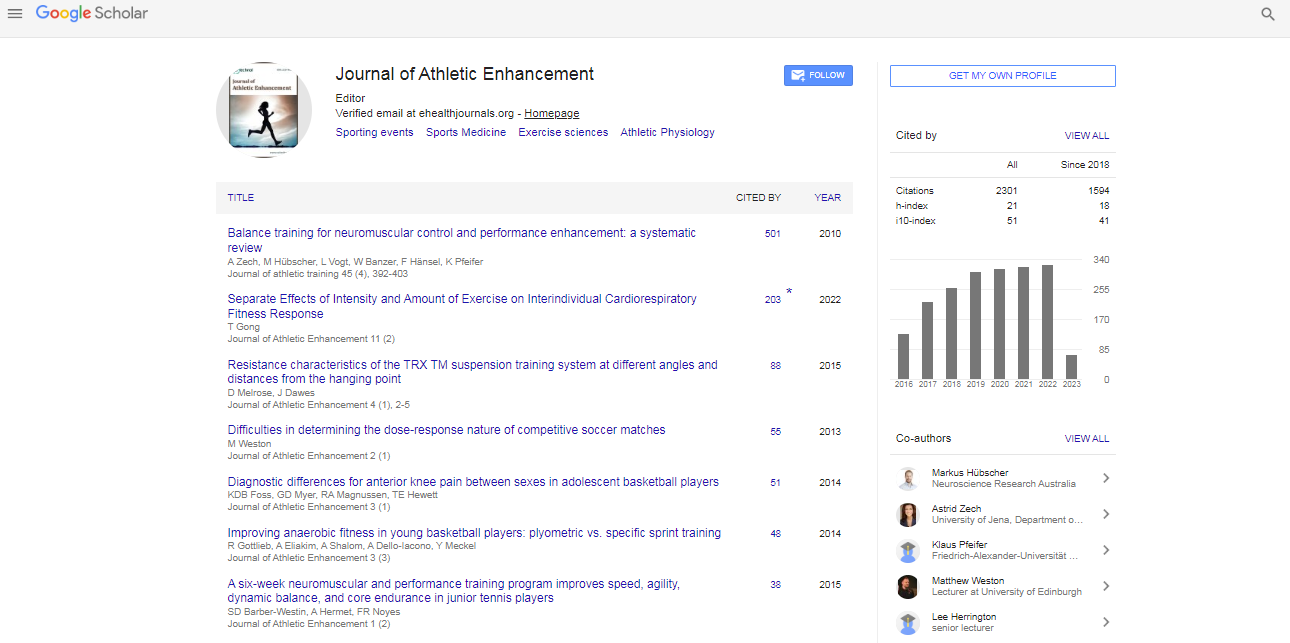Perspective, J Athl Enhanc Vol: 13 Issue: 4
Injury Prevention and Management for Peak Physical Performance
Zhang Xuan*
Department of Sports, Wuhan Sports University, Wuhan China
*Corresponding Author: Zhang Xuan,
Department of Sports, Wuhan Sports
University,
Wuhan China;
E-mail: xuanzhang@edu.cn
Received date: 28 June, 2024, Manuscript No. JAE-24-144918;
Editor assigned date: 01 July, 2024, PreQC No. JAE-24-144918 (PQ);
Reviewed date: 15 July, 2024, QC No. JAE-24-144918;
Revised date: 22 July, 2024, Manuscript No. JAE-24-144918 (R);
Published date: 29 July, 2024, DOI: 10.4172/2324-9080.1000141
Citation: Xuan Z (2024) Injury Prevention and Management for Peak Physical Performance. J Athl Enhanc 13:4.
Description
Injury prevention and management are important components of achieving and maintaining peak physical performance. Athletes and physically active individuals are constantly pushing their bodies to new limits, making them susceptible to injuries. By adopting a strategic approach to injury prevention and management, individuals can not only avoid setbacks but also enhance their overall performance and longevity in their sport or activity.
Injury prevention
Progressive overload: Gradual increases in intensity, duration and frequency of training help the body adapt without being strong. Sudden spikes in training intensity can lead to overuse injuries.
Strength and flexibility: A well-rounded conditioning program should include strength training, flexibility exercises and balance training. Strengthening muscles, tendons and ligaments can help absorb and distribute forces more effectively, while flexibility enhances joint range of motion and reduces stiffness.
Sport-specific training: Tailoring training programs to the specific demands of a sport ensures that athletes develop the skills and physical attributes necessary for optimal performance while minimizing injury risk.
Technique and form
Proper technique: Correct technique reduces the risk of injury by ensuring that forces are distributed appropriately and that movements are performed efficiently. This includes proper body mechanics, alignment and execution of techniques.
Regular assessment: Regularly assessing and correcting technique, with the help of coaches or trainers, helps identify and rectify poor habits or flaws that could lead to injury.
Warm-up and cool-down
Warm-up: A comprehensive warm-up increases blood flow to muscles, enhances joint lubrication and prepares the body for the demands of the workout or competition. Dynamic stretches and light aerobic exercises are effective components of a warm-up.
Cool-down: Cooling down with static stretching and low-intensity exercises helps reduce muscle soreness, aids in recovery and improves flexibility. It also helps in the gradual return of the body to its resting state.
Equipment and environment
Proper gear: Using appropriate and well-fitting equipment, such as shoes, protective gear and equipment specific to the sport, helps prevent injuries. For instance, well-cushioned running shoes can reduce the risk of stress fractures.
Safe environment: Ensuring that training and competition environments are free of hazards and are well-maintained contributes to injury prevention. This includes proper surface conditions and adequate facilities.
Rest and recovery
Rest days: Incorporating rest days and allowing time for recovery between intense training sessions helps prevent overuse injuries and allows the body to repair and strengthen.
Sleep and nutrition: Adequate sleep and proper nutrition are important for recovery and performance. Sleep promotes muscle repair and cognitive function, while nutrition provides the necessary nutrients for repair and energy.
Injury prevention and management are integral to achieving and sustaining peak physical performance. By emphasizing proper training, technique and recovery, individuals can reduce the risk of injury and enhance their performance capabilities. Effective management of injuries through timely intervention, rehabilitation and psychological support ensures a safe and successful return to activity. Ultimately, a proactive approach to injury prevention and management not only promotes peak physical performance but also contributes to long-term health and well-being.
 Spanish
Spanish  Chinese
Chinese  Russian
Russian  German
German  French
French  Japanese
Japanese  Portuguese
Portuguese  Hindi
Hindi 
